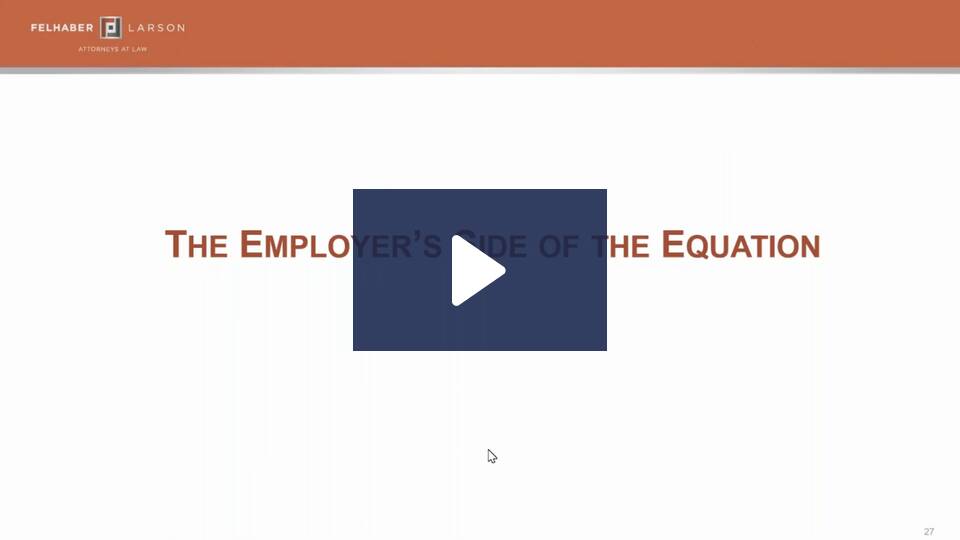{{cta-contact-popup="/components/rich-text-cta"}}
Minnesota’s new Paid Family and Medical Leave (PFML) law will take effect on January 1, 2026, marking one of the most significant compliance shifts for employers in decades. With broad coverage, new payroll taxes, and expanded leave rights, employers need to start preparing now.
Christensen Group recently hosted a webinar with attorneys Penny Phillips and Brian Benkstein of Felhaber Larson to help employers make sense of the new law. Below, we highlight the key PFML employer requirements, eligibility rules, tax implications, and action steps you should take now to be ready for 2026.

Who is covered under Minnesota PFML?
PFML coverage is broad—reaching almost every employer in the state. This includes:
- Minnesota-based employers of all sizes, from small businesses to large corporations and nonprofits
- Out-of-state employers with employees working in Minnesota
- Government entities
Employees are eligible if they work at least 50% of their time in Minnesota, or if they live in the state and perform a portion of their work here. Business owners and independent contractors are not automatically covered but may opt in voluntarily.
In short, almost every employer with Minnesota-based workers will be touched by this law.
Funding Minnesota Paid Family and Medical Leave
The PFML program will be funded through payroll taxes beginning January 1, 2026. Here’s how contributions work:
- Total tax rate: 0.88% of employee wages.
- Split: Generally 50/50 between employer and employee (0.44% each).
- Small business relief: Employers with 30 or fewer employees and lower average wages may qualify for reduced contributions or subsidies.
- Minimum wage protection: Deductions cannot reduce wages below the state or local minimum wage.
This cost-sharing model means every employer will have to account for PFML in their 2026 payroll budgeting.
State plan vs. private plan
Employers will be automatically enrolled in the state-run plan, but they can choose to offer a private plan if it meets or exceeds state requirements. The state plan is simpler to adopt, but it may create overlap issues with the federal FMLA.
A private plan, while requiring state approval, gives employers greater control. For example, organizations can align PFML with existing FMLA or PTO programs to minimize “stacking” of benefits and administrative complexity. Choosing between the two will be a key strategic decision for HR teams in the year ahead.
PFML eligibility rules and leave duration
To qualify, employees must meet a wage-credit threshold of about $3,800 in the prior year. Eligible employees may take:
- Up to 12 weeks of medical leave for their own serious health condition
- Up to 12 weeks of family leave to bond with a child or care for a family member
- No more than 20 weeks total of combined leave in a benefit year
One key difference from the federal FMLA is PFML’s broader family definition. Minnesota’s law covers in-laws, grandparents, and other relationships not recognized under FMLA—meaning employers may see employees qualify for PFML even when they wouldn’t qualify for FMLA.
PFML and FMLA: How they interact
While PFML and FMLA may sometimes run concurrently, employers shouldn’t assume they always will. For example, leave taken for an employee’s own medical condition would typically count toward both programs. However, leave to care for a mother-in-law qualifies under PFML but not under FMLA, meaning that if an employee takes leave to care for an in-law, they will be eligible for PFML and may also be entitled to take leave for their own serious health condition.
This distinction could extend employee absences significantly. Employers will need to update leave administration systems to track both programs and educate managers on when they overlap—and when they don’t.
Coordinating PFML with PTO and other benefits
Employers cannot require employees to use PTO before tapping into PFML benefits. Instead, employees may decide whether to use PTO to supplement PFML and increase income replacement. Short-term disability or similar benefits will also need to be coordinated so employees don’t receive duplicate payments.
For HR teams, this means revising PTO, parental leave, and disability policies. It also means training managers to understand that PFML fundamentally shifts how and when PTO can be applied.
Tax and reporting requirements
PFML contributions and benefits come with new tax obligations:
- Employer contributions above the 50% requirement are considered taxable wages
- Employee contributions must be shown on W-2s
- Family leave benefits are reported on Form 1099
- Medical leave benefits are partially taxable and reported on W-2s
Employers should ensure payroll systems are ready for these updates, though they should avoid providing direct tax advice to employees.
Administration and notice requirements
Employers will need to integrate PFML into their leave administration processes. Key requirements include:
- Portal management: Employers must designate at least one primary and one backup administrator to handle claims through the state’s portal
- Notice obligations: Employers must provide employees with written notice of PFML rights and display state-mandated posters
- Advance notice from employees: At least 30 days when foreseeable; otherwise, as soon as practicable
- Job protection:
- Fewer than 90 days of service → No reinstatement guarantee
- 91+ days of service → Guaranteed reinstatement to the same or equivalent position, with applicable raises {{cta-benefits-general-2="/components/rich-text-cta"}}
Special considerations for employers
Beyond the basics, several situations deserve extra attention:
- 2025 overlap: An employee on FMLA in late 2025 may still qualify for PFML in 2026 for the same event
- Health insurance premiums: Employers may need to directly bill employees for their share if no paycheck is being issued during leave
- Unionized workplaces: Payroll deductions must be negotiated in collective bargaining agreements
- Short-term disability programs: STD benefits will generally be secondary to PFML, requiring adjustments
Key dates to remember
- December 1, 2025: Employers must distribute and post PFML employee notices and notify each employee directly about paid leave
- January 1, 2026: PFML payroll deductions and benefits begin
- April 30, 2026: First quarterly premium payments due
How Minnesota PFML affects employers
The arrival of paid family and medical leave in Minnesota represents more than a compliance challenge—it’s a cultural shift in how organizations support employees during life events. Employers should evaluate whether to stick with the state plan or adopt a private plan, review leave policies, budget for payroll contributions, and prepare communication strategies for employees.
By acting now, employers can reduce disruption, ensure compliance, and position themselves as supportive workplaces when PFML takes effect.
8-Step action plan for Minnesota employers
To prepare for the Minnesota paid family leave employer requirements, HR teams and business leaders should:
- Assess exposure: Identify which employees will qualify under PFML eligibility rules in Minnesota.
- Budget for contributions: Model the payroll tax impact for 2026 and beyond.
- Decide on plan type: Evaluate whether to stay in the state plan or pursue a private option.
- Update leave policies: Align PTO, parental leave, and disability benefits with PFML requirements.
- Train managers: Ensure frontline leaders understand how Minnesota PFML affects employers and employee absences.
- Communicate with employees: Build an education plan around eligibility, benefits, and notice requirements.
- Prepare payroll systems: Coordinate with payroll vendors to meet new reporting obligations.
- Set compliance reminders: Plan for notices, poster updates, and the first payment deadline in 2026.
Webinar Question & Answers
by Penny and Brian at Felhabar Larson
Job protection & reinstatement
If I hire an employee to replace someone on extended leave, what are my obligations to the new hire?
You can hire a temporary employee only. If the position is clearly designated as temporary, there are no obligations to the replacement employee.
When an employee returns, must they resume the same position?
Employees with 90+ days of service must be reinstated to an equivalent position with the same pay, status, and benefits. Those with less than 90 days are not guaranteed reinstatement.
If the employee will be on PFMLA for 12–20 weeks and the position is crucial, can the employer keep the temp employee over the returning employee?
No. Employees with 90+ days must be reinstated.
Premiums, Taxes & Payroll
Will equivalent plan providers manage taxation on W-2s?
Not clear yet, but likely offered.
How will employers know how much is paid out for W2 reporting?
Unclear; the state has indicated it will report amounts to employers.
When hiring, can we start PFML deductions right away or wait until $3,800 earnings?
Begin deductions immediately.
Are premiums taxable?
Family leave benefits are not taxable. Medical leave benefits are subject to taxation on the employer share.
Are premiums due only for work after 1/1/26?
Yes. Deduct only for work performed in 2026.
Are they gross or net wages?
Gross wages, reported like unemployment wage detail reports.
Interaction with PTO, ESST, and STD
Can employees use PTO instead of PFML, then apply for PFML later?
Yes. Employers must report PTO use; DEED offsets it against PFML entitlement.
Can PTO/ESST accruals be stopped while on PFML?
PTO accrual can stop if the policy provides. ESST accrues only when working.
Can employees use PTO/ESST to top off PFML?
Yes, but employees—not employers—decide to use ESST. Employers may restrict PTO as a top-off.
Can employers force PTO use or PFML filing?
No. Employees must choose.
Can supplemental benefits be offered?
Yes. Employers may offer salary continuation, PTO top-off, or STD supplements, but pay cannot exceed normal wages.
Eligibility & coverage
Remote worker in WI covered?
No, unless 50% or more of the work is in MN.
Employee lives in MN but works in other states?
Eligible if 50% or more of work is in MN, or if not 50% elsewhere, and resides in MN.
Are minors covered?
Yes, if they earn wages.
Can a WI remote worker opt in?
No.
Are board members covered?
Possibly; coverage is broad if they receive wages.
Small vs large employer definition?
Small = ≤30 employees and lower average wages.
Are non-profits exempt?
No. Non-profits are covered.
Leave scenarios
If an employee had a baby in 2025, can they take PFML in 2026?
Yes, if within 1 year of birth.
If a baby is born in April 2024 and FMLA is used, are they eligible for PFML in 2025?
Yes, within 1 year of birth.
Can FMLA and PFML be used back-to-back?
Possibly. The state has not finalized. Employers may report previously taken leave to offset.
Why isn’t concurrent FMLA/PFML stacking?
Concurrent use = not stacking; only one benefit is paid. Stacking = sequential.
How does PFML interact with Workers’ Comp?
PFML is not available if WC benefits are being paid.
Administration & process
Can multiple admins access the state system?
Likely yes.
Is the application portal open before 1/1/26?
No, it opens on 1/1/26.
What is the deadline to submit equivalent plans?
Nov. 10, 2025.
Will the portal send email updates?
That is expected, but check manually too.
Can payroll link to the state system?
No, the state issues checks.
Does a private plan still use the portal?
No, work with your carrier.
Benefits continuation
Must employers continue benefits?
Yes, for all group insurance (health, dental, vision, life, disability).
401K, HSA, Roth contributions during PFML?
Unclear. Likely depends on plan terms. Continues if the employee receives employer pay.
Prepare confidently with Christensen Group
The launch of Minnesota Paid Family and Medical Leave is one of the most significant HR and compliance changes in recent memory. While it introduces new administrative responsibilities, it also reflects a broader shift toward supporting employees through critical life events. Employers who plan early will not only ensure compliance but also strengthen their reputation as supportive, employee-friendly workplaces.
At Christensen Group Insurance, we help organizations navigate complex benefit changes with confidence. If you’re ready to evaluate your options and build a compliance strategy, connect with our team today. Together, we can ensure your organization is fully prepared and positioned for long-term success.
To learn more, check out our complete guide to the Paid Family and Medical Leave Act.


.jpg)
.jpg)
.jpg)
.jpg)
.jpg)
.jpg)
.jpg)
.jpg)
.jpg)
%20(1).webp)